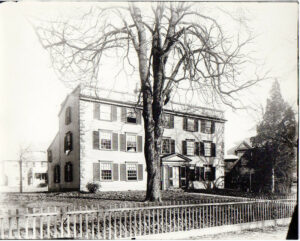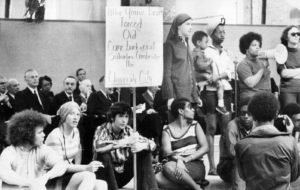Early Cambridge Newspapers
By George Grier Wright, 1928
This article can be found in the Proceedings of the Cambridge Historical Society Volume 20, from the years 1927-1929.
In the fall of 1839 two school boys, Peter L. Cox, aged fifteen years, and his brother Henry S., aged twelve years, conceived the idea of publishing a weekly paper for Cambridge. These boys belonged to a family of printers. An older brother published a paper in Virginia, and Peter became a well-known printer; of the younger no record appears.
Their first paper was called Brother Johnathan’s Youngest on account of its small size, of which only nine or ten numbers were published, the name having been suggested by the title of a paper called Brother Johnathan printed in New York on extra large-sized pages. This was followed by the Myrtle, a weekly paper with a five and a half by nine inch page; terms, four cents per month, single copies one cent. The change appears to have taken place February 28, 1840, being numbered Vol. 1, No. 20. The paper contained a variety of foreign and domestic news, list of marriages and deaths, and three local advertisements. It was discontinued March 6, 1840, No. 21, Vol. 1. It was succeeded by the Magnolia, October 22, 1840, published by the same parties, Peter L. and Henry S. Cox; terms, four cents per month, six copies twenty cents. August 26, 1841 (Vol. 1, No. 13) appears the following statement: “The Magnolia is intended for a family paper in which Temperance will hold a prominent position and it is the intention of the publishers to make it worthy of an extensive patronage.”
The paper was enlarged January 1, 1841, and again June 3, 1841, the terms being now one dollar per annum in advance. The brothers continued the paper until July 2, 1842, in its latter days being called The Cambridge Magnolia. With this number the paper was discontinued for lack of patronage, the advocacy of temperance preventing its receiving the support of many and the friends of temperance giving little support.
This was followed by the Penny Post. The paper bears no name as editor or publisher but was probably issued by Peter and Henry S. Cox. There is only one copy of the Penny Post in the Cambridge Public Library and one in the Harvard College Library, both of the same date. This number appears to be the only one published and no other copy appears in any collection known to me. It contained a number of news items and about a page of advertisements, few of them from Cambridge. It was probably the end of Cox brothers’ connection with Cambridge papers.
The Cambridge Palladium next appears, July 28, 1842, published weekly by Leonard Cox, Jr. and Company, terms, $1.50 a year, single copies three cents. The file in the Cambridge Public Library has only one copy, dated July 28, 1842; that in the Harvard Library, apparently a complete file, begins January 7, 1843.
When revived it had a fair amount of advertising and a large part of its space was filled with discussion of the merits and failings of the fire department. The paper continued until September 30, 1843.
The Cambridge Herald appears January 8, 1848, continuing until March 9, 1848, published weekly by Jacob N. Bang at $1.00 per year, single copies two cents.
The Cambridge Owl, April 13, 1848 — The Owl, July 13, 1848 to October 12, 1848 — the Plain Dealer and Spirit of the Times, October 26, 1848, Charlestown and Cambridge, were published weekly, single copies one cent, by Jacob N. Bang, a Boston printer located on Cornhill and living on Winsor Street, corner of Market, Cambridge. The reason for this change of name, four names in nine months, does not appear, as the papers are of the same character. This change of name appears to have been common to all these early papers, those of the Cox brothers as well as those of Bangs.
The Plain Dealer probably had a short existence as only one copy appears in such files as I have seen.
None of these papers could be called newspapers and apparently they must have had a small circulation. In 1846 the Cambridge Chronicle appeared, being the first really local newspaper in Cambridge, the first being dated May 7, 1846 (the same week in which the first city government was inaugurated). It was published weekly, terms $2.00 per annum. The first editor was Andrew Reid, whose career was of short duration.
Mr. Reid was succeeded by John Ford, whose name appears February 7, 1847 and continues until 1858. Mr. Ford was in reality the man who laid the foundation of the Chronicle.
Among those who followed Mr. Ford were George Fisher, Linn Boyd Porter, F. Stanhope Hill, and F. H. Buffam. Mr. Fisher enjoys the distinction of being, so far as my memory goes, the only Cambridge editor who has been publicly horsewhipped for his editorial utterance.
In December, 1891, Messrs. Seagrave and Bean purchased the paper and have continued to publish it to the present time.
In 1852 appeared the News Boy, published every fortnight by J. J. Lowell, A. A. Hayes, Jr., F. and P. W. Norris, proprietors. None of these names are in the Cambridge Directory and it appears like the venture of some boys.
The next adventure was the Wide Awake, published every two weeks, February 12, 1865, by Thomas Davis, otherwise known as “Propeller” Davis, a resident of North Cambridge, doing business as a printer- in Boston. As I recall, he was a somewhat erratic seeker after notoriety. It probably had a short life as the library contains only one copy.
The Moon, a paper for boys and girls, was published by Josiah S. Gushing and Edward F. Dunham, May 1871. It contained short stories and a fair amount of advertising. Only two copies are in the files of the Harvard Library, probably all that were issued.
In 1866 appears the Cambridge Press, published by James Cox. Hamlin R. Harding, former mayor, and Patrick H. Raymond, chief engineer of the fire department, served as assistant editors with Mr. Cox. Warren T. Billings, a Boston reporter by occupation, succeeded Mr. Cox in 1898 and the paper came to an end in 1905, with Alice Spencer Geddes and Arthur Lloyd as editors.
In 1878 (March 7) D. Gilbert Dexter started the Cambridge Tribune, published weekly, terms $2.00 per annum, the first number having the following introduction:
“In addressing the public for the first time through the Tribune we do not desire to come with any flourish of trumpets but in that modest way and manner which shall lead all who may see this initial number to be assured that we mean what we say. We do not intend to make promises which shall never be fulfilled but only those which will be more than fully realized in the work to come. We are aware it is not an easy task to establish on a firm foundation a new enterprise of this kind. Having looked the matter square in the face we feel safe in saying that success is assured us from the outset provided we give the public a good and reliable paper. This we promise faithfully and fully to do. We believe there is room in our goodly city for another journal and acting upon this belief we fling our banner to the breeze.
“Here we hope to give the best in literature and mother departments which go to make up a first class journal. In speaking thus some may say we do not intend to have anything but literature. Not so; we propose to have the best local paper which time and money can produce. While we shall not neglect ‘ the locals’ in the least, we still propose beyond that to make the Tribune of so high a standard in literature and other departments that it will find a ready and hearty welcome everywhere, especially in all our New England homes. It is our intent to make it the New England paper in a strict sense of that term. Our motto is independence without fear of any sort or party; charity towards all. Standing on such a platform, is it too much for us to ask the aid and influence of every true man and woman?”
The Tribune began publication in Brattle Square and has always been an Old Cambridge paper. The paper began its publication just after the people had become aroused by the disclosures of wastefulness and dishonesty at City Hall. The water registrar had been found to be a defaulter, the city messenger had approved bills for stationery in large amounts which were in fact for cigars, and there was general looseness in the transactions at City Hall. The valuation was decreasing, the rate of taxation was increasing ($5.50 per $1,000 in four years), population decreasing. The Tribune commenced its career by publishing a stenographic report of the meeting of the Board of Aldermen each week. After a few months this was abandoned, whether from lack of interest or expense I never knew. The Tribune has always been well conducted, being especially neat in its typographical appearance, and its columns were always free from language calculated to cause offense. Among its contributors in the past years have been the poets Longfellow, Lowell and Holmes, T. W. Higginson, William Winter, Rev. Dr. A. P. Peabody, Alexander McKenzie and Edward Abbott, Bishop Lawrence, Professors Norton, James, and Hart.
Mr. Dexter was followed as editor by William B. Howland, F. Stanhope Hill, Henry H. Harrison, Edward F. Gamwell, and J. Lee Robinson.
In 1879 appeared the Cambridge News and Real Estate Advertiser which continued its existence until the death of its founder, Daniel A. Buckley, in 1901. The paper was a free lance, being essentially the personal organ of its owner. It probably was practically supported by him and its circulation among regular subscribers was limited. Its issue did not exceed six hundred copies weekly as three newspaper directories agree on about that circulation. Mr. Buckley’s direct and incisive ways of stating facts caused his editorials to be read and repeated by more people than the editorials of papers with a larger circulation.
A weekly paper began its publication in August 1885 or 1886. The editor was John S. Browning, an advertising agent for the Boston Globe and other papers, and the paper carried at the head of the editorial column the following statement: “a local newspaper politically independent, the official advertising medium of the city, devoted especially to governmental affairs.”
In 1888 the Cambridge Daily began its publication, which continued a little more than a year, the longest period any daily had been able to exist at that time. The editor and manager was Warren F. Spaulding, who made the paper interesting and its appearance attractive.
The next paper to greet the public of Cambridge was the Cambridge Times, published in East Cambridge by James Livingston. It was issued weekly, price two cents, and its field was practically East Cambridge, although general news of the city was not neglected. Mr. Livingston was followed in 1907 by George R. Brine, who had in earlier years served as a member of both branches of the City Council. In 1901, to meet what some citizens thought was a need of our city and to uphold the interests of the Democratic Party locally, appeared the Cambridge Democrat. Grenville S. MacFarland, a recent graduate from Harvard College, was its editor and he kept the paper going until December 19, 1903.
The paper was published weekly, price two cents, and its editor wielded a vigorous pen in behalf of the virtues of his party. A division among its supporters finally caused its death from lack of support.
Following the Democrat appeared the Cambridge Sentinel, October 31, 1903, a weekly Democratic paper, subscription $1.00 a year, edited by William E. Nickerson. Mr. Nickerson was followed by Henry J. Mahoney and Daniel J. Toomey as editors about 1907. Upon Mr. Toomey’s election as clerk of committees, Mr. Mahoney became the sole editor.
The same year appeared the Union Advocate on August 20, 1903, T. A. P. Boardley and C. H. Evans editors, a local paper published weekly in the interests of unionism.
In 1905 the Cambridge Mirror began its publication, with William H. Lee editor. This weekly journal was “published in the interest of Afro-American people and of our advertisers.”
In 1906 the Advocate, another paper in the interest of our colored fellow-citizens, appeared, according to the newspaper directory. It appears to have been published by the Advocate Publishing Company, William Grandison, as printer-manager, with John W. Springer as editor. The paper later passed into the hands of the Commercial Pioneer Association and in 1910 it became the property of J. Thomas Harrison, a printer. Mr. Harrison continued the paper until 1922, when it suspended publication.
In 1907 the Cambridge Free Press, a weekly paper, began publication. Little can be learned about it, as the paper bears no name as editor. It does not appear to have been published much over a year.
In 1911 the Cambridge Recorder, a Democratic paper, appeared under the editorship of Edward J. Sennott and John J. Scott. Mr. Scott was followed by James H. Murphy.
The same year the Cambridge Evening News began its career under the guidance of George H. Pratt, apparently for about a year.
In 1912 the Cambridge Standard under the management of Charles Wayland Towne, former publisher of a local paper in Newburyport, began its efforts “to help to make Cambridge conscious of its possibilities, constructive in its planning, cleaner in its politics.” This was the most determined attempt to establish a daily paper in Cambridge which has been made so far. It was published about six years and owes its long career to Theodore H. Raymond, whose ambition it was to build a paper in Cambridge with a standing and influence like the Springfield Republican.
The Gridiron in 1915, an independent sensational political paper, published weekly, subscription $1.00 per year, had a short career of about a year under the editorship of Harold D. Carew and was followed in 1917 by Public Opinion, of the same character and subscription price, with the same editor and having an equally short life.
In 1920 the Cambridge Sun, a semi-weekly, entered the field under the editorship of Ralph R. Stratton. Its publication lasted apparently a little over a year.
In 1920 the Cambridge Home News, another semi-weekly, began its existence, with John J. Wallace as editor. For a short period it was issued daily and finally ended after a period of about six months.
The last paper to appeal for the support of the public was the Cambridge News, which began its publication March, 1922. This was a weekly publication devoted to “the betterment of the civic, mercantile and industrial conditions in Cambridge.” Its editor, J. Frederick Flemming, was a reporter by occupation. It was really an advertising sheet, containing little news, and had only about six weeks’ existence.






